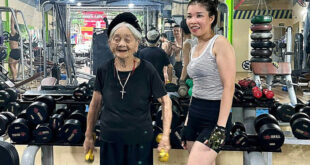Tran Dinh Phuc bent down to enter his tiny room, which has just enough space for a folding table and a person to lie down.
The 21-year-old from the central Nghe An Province describes his rented accommodation, which is around three square meters as a “matchbox”. He has been living in it for the last two years.
“I work from morning to night, and all I need is a place to sleep for the night. I don’t have any furniture, so I don’t want to spend a lot of money on renting a big room.”
He used to rented a 15-square-meter room for VND3-3.5 million ($127-149) a month, but with his limited income it became too much of a burden. Fortunately for him, the so-called nha tro to ong (beehive room) started to emerge in Vietnam.
“Now I only have to pay VND1 million a month plus utilities and service costs. Despite its low cost, it meets my convenience and cleanliness standards.”
 |
|
Tran Dinh Phuc inside his 3-square-meter room on Hanoi’s Nguyen Phuc Lai Street on August 25, 2022. Photo by VnExpress/Quynh Nguyen |
Hung Cuong, Phuc’s downstairs neighbor, who has been renting here since 2019, says the total monthly cost of rent and utilities is less than VND1.5 million.
“This accommodation was especially ideal for low-income people through the two years of Covid and now amid the inflation.”
Kieu Trang, 19, a sophomore at the Trade Union University in Hanoi’s Dong Da District, appreciates that the rent here does not leave a dent in a college student’s wallet and says it is ideal for people living alone like her.
When she first came to the property on Nguyen Phuc Lai Street in Dong Da District, she was startled to discover that the whole building was 15-20 square meters but had two floors and was divided into several little rooms.
Since her three-square-meter room has a window, her rent is VND1.2 million, VND200,000 more than Phuc’s, but if tenants sign a six-month contract, the rent is reduced, she says.
“People might think that the room is cramped and stuffy. But since I always let the air conditioner on, my room is extremely cool. Not to mention that I can use the common washing machine, bathroom water heater and kitchen as much as I need.”
 |
|
Kieu Trang’s room with windows. Photo by VnExpress/Quynh Nguyen |
These beehive rooms, known as ‘goshiwon’ in Korean first appeared in South Korea about 40 years ago and was designed to serve college students so they can shut themselves off from the outside world to study for exams.
Nowadays, this style of accommodation is common in Japan and Hong Kong, with rooms measuring three to five square meters, primarily serving students, international students and low-income workers since all they need is a place to sleep.
In Vietnam they appeared in 2019 in urban districts in Hanoi. Each of these properties has up to five floors with shared parking space, a kitchen on the first floor and a clothes drying area on the terrace. The remaining floors have rooms with just enough space for one person.
The building where Phuc, Trang and Cuong live has 33 rooms in all, each with light bulbs, outlets, hanging shelves, and ventilation fans. All rooms are connected to a centralized air-conditioning system.
The hallway, kitchen, toilet and drying area are cleaned once or twice a week. A technical crew is always on hand to fix any problem with any equipment in the rooms.
 |
|
The shared kitchen on the first floor. Photo by VnExpress/Quynh Nguyen |
Chu Duy Luyen, 27, who manages a chain in Hanoi with 200 buildings, says of around 2,000 people who have rented in its three years of existence, men have accounted for 60-70%.
“During the pandemic the number of occupants fell by 30% as students and workers returned home. However, earlier this year the number rebounded to pre-pandemic levels. The occupancy rate is always 90-95%, and the average rental duration is six months.”
The low rents come with some obvious disadvantages like noise and fire hazard.
“If the person above turns on the speakerphone or speaks loudly, people below can hear everything,” Trang says.
Furthermore, more than a dozen people have to use a single toilet on each floor, resulting in long lines early in the morning and late at night.
Nguyen Ngan of Cau Giay District used to rent a room to save money, but moved out quickly because she was concerned about fire safety.
“The rooms are separated by wood, and I was frightened an unfortunate fire accident would be a risk to my life,” she says.
“So I accepted paying higher rent in exchange for peace of mind.”
Luyen dismisses such fears, claiming the unit has signed a pledge with the authorities on fire safety, the wood used to partition rooms is fire retardant and tenants are not permitted to smoke inside.
“There are fire extinguishers and rope ladders on every floor.”
However, when asked to show the paperwork required for fire safety, he is unable to furnish it.
But Phuc, despite living in a confined place with possible risks, says he is content with it because of its low price.
“Even if my income increases, I will continue to live here because it meets my needs and helps me save money for other things.”
- Reduce Hair Loss with PURA D’OR Gold Label Shampoo
- Castor Oil Has Made a “Huge” Difference With Hair and Brow Growth
- Excessive hair loss in men: Signs of illness that cannot be subjective
- Dịch Vụ SEO Website ở Los Angeles, CA: đưa trang web doanh nghiệp bạn lên top Google
- Nails Salon Sierra Madre
 VnExpress News The News Gateway of Vietnam
VnExpress News The News Gateway of Vietnam





